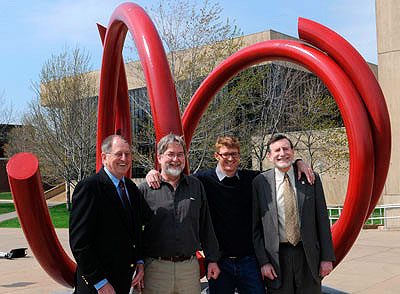|
From left are Lake Shore Savings Board Chairman Michael Brunecz, SUNY Fredonia Visual Arts and New Media Professor Bob Booth, “Popeye” creator John Clement, and SUNY Fredonia President Dennis Hefner. |
Amid the distinctive, poured-concrete architecture that is so widely associated with the SUNY Fredonia campus, a bright red sculpture of intertwining steel spirals has commanded the attention of passersby over the last two years.
Now, campus officials have agreed it’s a look they want to keep.
The striking, nearly 1,600-cubic-foot sculpture known as “Popeye,” which has called the front walkway of the Michael C. Rockefeller Arts Center home since May 2007, has found a new permanent home – about six feet from its present one.
The three-ton creation of Brooklyn-based artist John Clement was officially dedicated Thursday, April 30 as a permanent fixture among the SUNY Fredonia landscape, thanks to a gift from Lake Shore Savings, a long-time supporter of SUNY Fredonia. The company has sponsored cultural events on campus for more than 20 years and is in its second year as a season-wide sponsor for all Rockefeller Arts Center activities. In 2001, as part of the university’s 175th anniversary, Lake Shore Savings purchased the clock tower that has become an icon for the institution. The “Popeye” gift is part of the Fredonia College Foundation’s “Doors to Success” capital campaign, which runs through 2011.
“Popeye” originally came to Fredonia as part of the campus’ In Sight/On Site program, directed by Distinguished Teaching Professor Bob Booth from Fredonia’s Department of Visual Arts and New Media. The program, supported by the student art group ARTFORUM and the Friends of Rockefeller Arts Center, is designed to give college students and community members the opportunity to see contemporary sculpture examples while creating an appreciation of art in public spaces.
Clement was on hand at the official installation ceremonies for his 12-foot-high work outside of Rockefeller Arts Center. He operates Firehouse Studios in Brooklyn, is a graduate of the University of Pennsylvania, and attended the School of Visual Arts in New York City. Through the years, Clement has repeatedly seen the wonderfully positive impact a public work of art can have on a community.
“Art is a wonderful and essential element of our society,” Clement said when the piece was initially loaned to the university. “It is the task of public art to break down the seemingly elitist barriers which prevent many individuals from seeking out art in museums and galleries.”
“Popeye” was created with eight-inch diameter welded steel pipe, according to Clement, and its original temporary base was fabricated from one-inch thick steel plate and 12-inch-by-12-inch wood timbers. The physical process of construction was about two months long. It sits on a concrete base at SUNY Fredonia.
Many are surprised to learn of the origin of the sculpture’s name, whose story isn’t as deep and profound as one might expect.
“I was waiting for a plate of steel to be delivered (for the base section) and the trucker was lost,” Clement explained. “When he did arrive, he was quite a character. His name was Popeye! The name really caught my ear, and I started to refer to the work as ‘Popeye.’ Obviously it stuck!”
Under the In Sight/On Site program, SUNY Fredonia has accepted a variety of outdoor sculpture for an ongoing, revolving installation on campus with pieces seen all across its beautiful, nearly 250-acre campus. “Popeye” will be the first of these loaned pieces to become a permanent fixture, thanks to the financial support of Lake Shore Savings, which will also have various company representatives on hand for the installation, including Board Chairman Michael E. Brunecz.
“Artists are chosen by a committee comprised of myself and students from ARTFORUM. We research appropriate artists from a variety of sources and contact those whose work is interesting and appropriate for outdoor display,” Booth said. “The artists are provided with information about the program, limitations of budget and installation date preferences. We all work together to make it happen.”
Clement has been featured in the New York Times and has participated in numerous group exhibitions in Chicago and New York City, in addition to several solo exhibitions.
Public installations of his works have taken place in Florida, Connecticut, Massachusetts, New Jersey, Kansas and New York, and permanent displays can be found in New York, California and Texas as well as in Japan, China and British Columbia.




